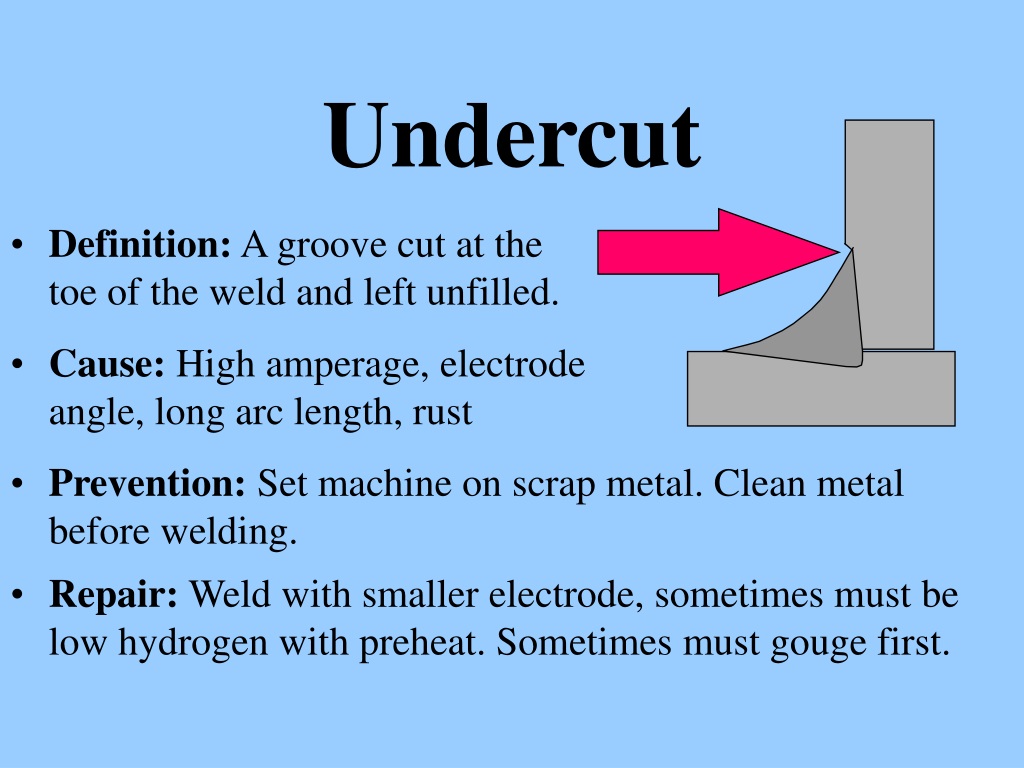How to Prevent Weld Undercut: Necessary Tips for Welders
How to Prevent Weld Undercut: Necessary Tips for Welders
Blog Article
A Comprehensive Overview to Identifying, Fighting, and Correcting Undercut Welding Problems in Your Welding Tasks
In the realm of welding, encountering undercut concerns is a typical difficulty that can jeopardize the structural integrity and general high quality of your welding jobs. Comprehending the source behind undercut welding, having the ability to precisely find it in your welds, and applying reliable preventative measures are critical skills for any welder. In addition, having the knowledge and techniques to remedy undercut troubles when they do take place can make a substantial difference in the final result of your welding ventures. Stay tuned as we explore the vital parts of identifying, protecting against, and repairing undercut welding problems, offering you with beneficial insights and methods to raise your welding skills to the next degree.
Common Sources Of Undercut Welding
Undercut welding, a typical issue in welding procedures, can be brought on by numerous elements that require to be meticulously determined and resolved to guarantee the stability of the weld joint. Among the main root causes of undercut welding is too much warm input. When the welding specifications, such as voltage, existing, or take a trip speed, are not appropriately established, an extreme quantity of warm can be generated. This excess warm causes the melting and subsequent removal of the base material along the edges of the weld joint, creating a groove recognized as undercut.
One more common source of undercut welding is inappropriate welding technique. Poor adjustment of the soldering iron or weapon, inaccurate angle or distance in between the torch and the workpiece, or irregular travel rate can all contribute to the development of undercut. In addition, using the incorrect welding consumables or electrode size for a certain joint arrangement can bring about undercut issues. Identifying these source and executing restorative procedures is essential in avoiding and correcting undercut welding troubles in welding tasks.
Identifying Undercut in Welds

To identify undercut precisely, appropriate lights and magnification devices are vital to examine the weld joint completely. Using devices such as a welding scale or a magnifying glass can help in identifying even the smallest undercut blemishes. Additionally, running a finger or a fingernail along the weld joint can occasionally reveal undercut, as the surface area may really feel unequal or have a dip where the linked here undercut exists.
Safety Nets for Undercut
Having a deep understanding of the reasons of undercut in welds allows for the implementation of reliable preventive actions to maintain weld top quality and honesty. These setups must be maximized to protect against excessive warm input, which can lead to damage development.

Techniques for Fixing Undercut

Enhancing the welding present or reducing the travel rate can assist fill up in the undercut. Furthermore, altering the welding technique from a press to a drag or vice versa can likewise aid minimize undercut.
One more technique is to use a weaving activity while welding to ensure correct sidewall combination and fill in the undercut. By oscillating the welding arc from side to side within the weld joint, the welder can transfer extra filler material right into the undercut locations, efficiently eliminating the flaw.
Moreover, grinding out the undercut and rewelding the joint can be a feasible service for much more severe undercut problems - Preventing weld undercut. This procedure entails eliminating the undercut section, preparing the base steel, and after that rewelding the joint with appropriate welding criteria and methods to avoid undercut from repeating

Specialist Tips for Preventing Undercut
Utilizing appropriate welding techniques great post to read and keeping control over crucial welding specifications are crucial methods for welders intending why not look here to avoid undercut in their weld joints. In addition, picking the ideal welding process and filler steel for the specific application can help prevent undercut. Maintaining a consistent traveling speed throughout the welding process is an additional crucial pointer to avoid undercut.
Conclusion
To conclude, recognizing, avoiding, and dealing with undercut welding issues in your welding jobs is critical for guaranteeing sturdy and strong welds. Preventing weld undercut. By recognizing the usual root causes of undercut, having the ability to identify it in welds, implementing precautionary measures, and making use of appropriate methods for fixing undercut, you can stay clear of possible concerns and create top quality welds. Complying with professional pointers for staying clear of undercut can aid you boost your welding skills and generate better results in your projects
Undercut welding, a common issue in welding procedures, can be triggered by various variables that require to be meticulously identified and dealt with to ensure the integrity of the weld joint. In addition, running a finger or a fingernail along the weld joint can in some cases expose undercut, as the surface might really feel uneven or have a dip where the undercut exists.
Making use of proper welding strategies and maintaining control over key welding specifications are vital methods for welders aiming to stop undercut in their weld joints.In conclusion, determining, preventing, and taking care of undercut welding troubles in your welding projects is critical for making sure long lasting and strong welds. By understanding the typical causes of undercut, being able to determine it in welds, carrying out preventative measures, and using appropriate techniques for dealing with undercut, you can stay clear of prospective problems and create top quality welds.
Report this page